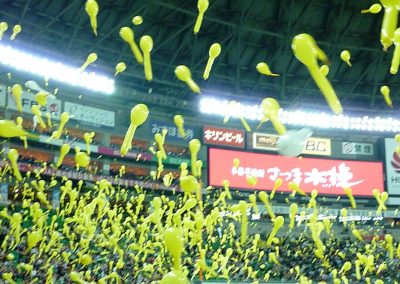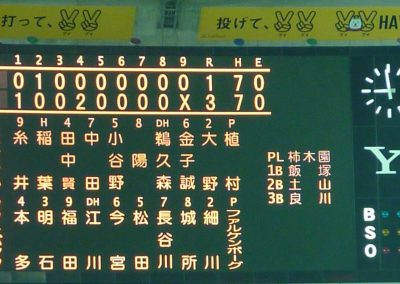Fukuoka PayPay Dome - Fukuoka SoftBank Hawks
- Sean MacDonald
- Jul 1, 2013
- 7 min read
Updated: Mar 29, 2023
Photos by Sean MacDonald, Stadium Journey
Stadium Info FANFARE Score: 2.71
Fukuoka PayPay Dome 2-2-2 Jigyohama Chuo-ku, Fukuoka 810-8660 Japan
Year Opened: 1993 Capacity: 38,561
Ad Hawks
Corporate ownership is the norm in Japanese baseball, with franchises merely considered an asset among many in the large conglomerates that control them. As such, when a company falls on hard times, it often looks to sell the team as they are often money-losing operations that provide little more than publicity. Such was the case in the 1980s when Nankai Electric Railway, based in Osaka, found their overall business hampered by their terrible ball team known as the Hawks. The board wanted to sell, but the chairman prevented it as he was an ardent supporter of the team. When he died in 1988, the last obstacle disappeared and Nankai sold the Hawks to Daiei, a retail business with supermarkets throughout Japan. Daiei moved the team to Fukuoka, the largest city on the southern island of Kyushu, where they became the Fukuoka Daiei Hawks.
The team played four seasons in Heiwadai Stadium, a relic from 1928, and the new owners realized they needed a modern venue to show off their shiny new possession. In 1993, they opened the Fukuoka Dome, Japan’s first stadium with a retractable roof and the Hawks have stayed there ever since. Of course, Daiei themselves fell into bankruptcy and in 2005, they were forced to sell the team to mobile phone operator SoftBank who renamed the team Fukuoka SoftBank Hawks. That same year, they sold the naming rights to the dome to Yahoo! Japan, and the venue is now known as the Fukuoka Yahoo! Japan Dome, or Yahoo Dome for short. The dome is now known as the Fukuoka Yahuoku! Japan Dome
It is the biggest dome in Japan, which has six of these monstrosities in the NPB, a necessity due to the rainy season that slams the country in late spring. The roof is made of titanium and is so valuable that in 2004, Tom Barrack, a billionaire real-estate mogul, bought the dome simply because the roof alone was worth the purchase price.
All that is well and good, but the key question is how does the Fukuoka Dome measure up in the important aspects of the fan experience?
Food & Beverage 3
Food options are not as good as at some other parks in Japan and I struggled to find something unique. This is not to say that the offerings are limited, but that they are generally things you can find at other stadiums or cheap restaurants on the outside. I settled on a chicken burger in a focaccia bun, which came with a soft drink for 780 yen. Not exactly cheap eats. Interestingly, you fill up your own drink here, something I’ve not seen at other ballparks – the clerk puts a lot of ice in an empty cup and you fill the cup much like at fast food restaurants.
Speaking of fast-food, KFC and Subway are two of the American brands here, each with several stands around the main concourse. Mos Burger, a smaller, tastier hamburger is also present, but I would recommend the DomDom Burger stand instead, simply because it is not widely available. Another popular spot was Umakamon Street with yakitori, various types of yakisoba (fried noodles) and crepes for dessert.
If you want something unusual, the fried squid should fit the bill. As usual, explore all the options and you should find something to enjoy.
Alcoholic beverages are plentiful with all the Japanese staples widely available, beer being the most popular choice. The beer servers moved up and down the aisles pretty much up to the end of the game.
Atmosphere 1
Japanese baseball games are loud due to the two cheering sections in the outfield, but the Hawks take things to the extreme and it can be painful if you prefer a quieter atmosphere. To begin, there is an MC named Max, an overly hyper DJ from Chicago who started working here in 2007. He first appears before the game to get things going with lots of rah-rah (in both English and Japanese) and then becomes more and more irritating with between-inning appearances (called Max Time!) where he interviews fans. You probably have to live in Japan for a while to appreciate just how bloody awful this is; foreigners acting goofy is a staple of Japanese TV and seeing it brought to the ballpark was depressing and really brought down the experience, at least for me. Tourists may think differently though and so I’m not docking more than 2 points for the constant bombardment of noise.
There was a dance team and at least six mascots to keep fans entertained and the size of the dome keeps the cheering sections relatively quiet when you are sitting near home plate. In fact, I would say it was quieter while the game was being played and only became noisy during the inning breaks, a change from the usual pattern here.
Neighborhood 2
The dome is a 10-minute walk from Tojinmachi subway station, which is itself just 15 minutes from downtown Fukuoka, so it is easy to get to. The venue is part of a larger complex called “Hawks Town” which consists of a mall, several restaurants including a Hard Rock Cafe, and a Hilton hotel (called the Sea Hawk in keeping with the theme). The surrounding area is next to the waterfront and there is a beach just on the other side of the highway, although I didn’t immediately see how to access it. If you have time and the weather is nice, it is worth exploring this area before the game but afterwards, you’ll probably want to take the subway back to Tenjin, the main nightspot in Fukuoka.
If you are staying around Tojinmachi, a new izakaya recently opened right next to exit 2. Nipachi is a chain restaurant where all items are just 280 yen. There are other branches throughout the city that provide a simple and affordable post-game dining experience.
Fans 4
Hawks fans are excellent, usually showing up in large numbers and staying active throughout the game. Nearly everyone participated in the balloon release during the lucky 7th inning and after the team won, most stayed for the celebrations. For about 30 minutes there were hero interviews, singing of the team song, fireworks, and more balloons being released and few left to beat the traffic. I must say that the fans seemed to really enjoy themselves here and although the atmosphere is not something I particularly like, having such good supporters around me made a big difference.
I find that fans here have been friendly whenever I’ve attended a game and this time was no different as I chatted with a couple of ladies who were kind enough to show me around town after the game.
Access 3
Despite being much larger than the Tokyo Dome in terms of its actual footprint, Fukuoka Dome only has a single seating bowl with 32 aisles that provide access from the main concourse. You can walk around the entire concourse, but it gets busy when a crowd of 35,000 fans is on hand.
Don’t try to enter the good seats without a ticket; each aisle is manned by an eager usher who will not let you pass unless you are ticketed for that specific aisle. Once in the seating area, you are again limited to how far you can go as plastic fencing blocks you from moving to a different section of seats. Not good if you are trying to get pictures, but you can enter the outfield sections at any time as they are the least expensive, so no ticket check is required.
Washrooms are not sufficient; I noticed large lines both during and after the game.
Return on Investment 2
The Hawks have been one of the NPB’s most successful teams in recent year, and are the defending Japan Series champions. As such, they are charging much more for tickets than the other clubs, with seats behind the plate going for as much as 10,000 yen. The seats are the big and comfy type, but $120 is way too much for a baseball game in my mind.
If you like to be close to the action, the S reserved seats are 5,500 yen, still a bit overpriced. The best bet might be the outfield reserved seats listed at 1,800 yen but marked down to 1,000 yen at the game I attended.
If you are not interested in getting inside the stadium proper, you can try the museum experience. Above the outfield seats is a museum dedicated to Sadaharu Oh, the world record holder with 868 home runs. For just 1,400 yen, you can visit this and see the game. This used to be a restaurant (similar to Windows in Rogers Centre) and I sat here a few years ago and found it strange, as you can’t hear the sounds of the game. Perhaps the Hawks thought the same as they created a museum to honor Oh, who managed the team for several years and is now the chairman. The museum is open before the game as well, so try to get there early and pay it a visit.
There are three video boards above the outfield seats but two of them are used exclusively for advertising. These were given the names “Left Wing Vision” and “Right Wing Vision” in an obvious attempt to show that regardless of political bent, commercialization is the key to happiness.
In fact, that was the main theme I took away from my visit here – spend, spend, spend. Things are expensive here, and I found myself inundated with commercials, right from when I walked through Hawks Mall on the way to the stadium.
There are logos everywhere around and even Max got into the act, interviewing a couple of young ladies in English, sponsored by a local language school.
The combination of an overpriced product and the non-stop solicitation to spend even more money really makes this the least cost-effective stadium in the NPB.
Extras 4
There are a few displays worth noting as you wander around. First, at every gate there are “V” shaped pillars that commemorate each of the Hawks’ 15 Pacific League titles as well as the two championships they won in the Japanese Baseball League.
There is a Material Wall that simulates a pitchers mound and home plate, exactly 18m44 apart (that’s 60’6″ for those who don’t know metric).
There are pictures of every member of the entire Hawks’ roster, including those on their minor league team, shown under their place of origin.
Most importantly is the Oh museum, located near gate 9 and open during non-game days as well. You can also take a tour here but I did not have time to do so on this occasion.
Final Thoughts
The Fukuoka Dome is an impressive structure and well worth visiting just for that. The game experience is a different matter though. For me, I found much of it to be excessive, from pricing to noise to advertising and that put a damper on what should otherwise have been a fun evening. The Hawks have a great team and should spend less time distracting their fans from the product on the field.
Follow all of Sean’s journeys at Sports Road Trips.






Comentarios